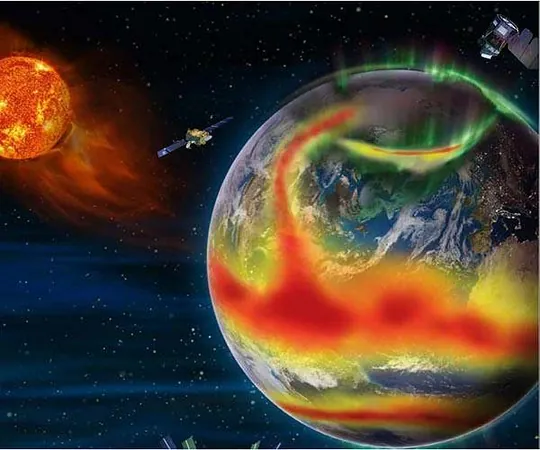
Why Ignoring Space Weather Could Put Your Life at Risk!
2025-01-13
Author: Jia
Space weather is a silent but formidable force impacting our lives in ways that many people remain blissfully unaware of. It threatens everything from technology and infrastructure to human safety. Understanding space weather is no longer a niche subject for scientists—it is a crucial part of safeguarding our modern way of life.
As we navigate our increasingly tech-dependent world, the importance of monitoring solar activity cannot be overstated. Just as we plan events around terrestrial weather, we need to stay attuned to the unpredictable forces from the Sun, which can unleash powerful energy bursts that affect Earth in dramatic ways.
What Is Space Weather?
Space weather refers to the conditions in space influenced by solar activity and the solar wind—an ongoing stream of charged particles emitted by the Sun. These solar emissions interact with Earth's magnetic field, potentially leading to geomagnetic storms that can disrupt our daily lives. Solar phenomena such as solar flares and coronal mass ejections eject vast quantities of energy and particles into space, causing fluctuations that affect our planet's technology.
The Modern Dangers of Space Weather
Satellites and GPS Systems
Nowhere is the impact more immediate than in satellite communications and GPS technology. Solar radiation can damage satellite electronics, resulting in poor communications and reduced GPS accuracy. Airlines, shipping companies, and emergency services rely heavily on these technologies; even minor disruptions can translate into significant economic losses and operational delays. For example, during intense solar storms, hacked or unstable GPS signals could put your flight safety at risk!
Power Grids
Geomagnetic storms induce electric currents in power lines, stressing transformers and sometimes leading to widespread outages. The infamous blackout in Quebec in 1989, caused by a geomagnetic storm, left millions in the dark for hours. As power grids become more interconnected, the potential for cascading failures increases, revealing the critical need for resilience in these systems.
Aviation and Communication
Space weather poses unique challenges for the aviation industry as well. Solar storms can force airlines to reroute flights, especially over polar regions, significantly increasing fuel costs and travel times. Similarly, high-frequency radio communications crucial for military operations may face disruption, complicating operations during emergencies.
Advancements in Space Weather Prediction
Understanding these phenomena is essential, and agencies like NASA and NOAA are at the forefront of monitoring solar activity. Using advanced satellites such as the Solar and Heliospheric Observatory (SOHO), scientists track solar flares and other activities to anticipate potential threats to Earth. While predictions may not be as precise as regular weather forecasting, they provide valuable lead time to mitigate risks.
Historical Context: Learning from the Past
1. The Carrington Event (1859): A massive geomagnetic storm that disrupted telegraph systems and left auroras visible as far south as the Caribbean. Experts warn that a similar event today could be catastrophic for our modern infrastructure.
2. The March 1989 Geomagnetic Storm: This powerful storm knocked out power in Quebec and damaged multiple transformers across the U.S., highlighting our vulnerability.
3. The Halloween Storms (2003): A series of solar storms that disrupted various technologies and even prompted rerouting of flights.
The Rising Need for Awareness
As our technological reliance mounts, so does the need to understand space weather. Satellites are integral to everything from Internet services to emergency responses—any disruption could trigger a chain reaction affecting economies and livelihoods. Furthermore, astronauts embarking on missions to the Moon or Mars face significant health risks from solar radiation, making reliable space weather predictions more vital than ever.
Preparing for Future Challenges
International collaboration is essential in this fight. Agencies like NASA, ESA, and NOAA are hard at work to develop early warning systems and improve data-sharing across borders. Governments and industries alike invest in technologies designed to make power grids resilient, create radiation-resistant satellites, and establish backup communication systems.
Public education is also critical. Communities must be informed about potential disruptions, enabling a collectively sharp response to space weather events. Schools and media outlets have significant roles in elevating awareness of this unseen yet omnipresent threat.
Conclusion: Don’t Underestimate Space Weather!
Space weather is an often-overlooked yet vital aspect of our Earth's safety and stability. Its effects extend from technology directly into our daily lives, making it paramount to monitor and understand. As humankind ventures further into space and leans more on technological infrastructure, an informed approach to space weather will be crucial. Investing in research, fostering international cooperation, and enhancing public awareness are steps we must take to ensure we’re ready for whatever the Sun throws our way.
Stay tuned, informed, and prepared—because the next solar storm could strike without warning!
 Brasil (PT)
Brasil (PT)
 Canada (EN)
Canada (EN)
 Chile (ES)
Chile (ES)
 Česko (CS)
Česko (CS)
 대한민국 (KO)
대한민국 (KO)
 España (ES)
España (ES)
 France (FR)
France (FR)
 Hong Kong (EN)
Hong Kong (EN)
 Italia (IT)
Italia (IT)
 日本 (JA)
日本 (JA)
 Magyarország (HU)
Magyarország (HU)
 Norge (NO)
Norge (NO)
 Polska (PL)
Polska (PL)
 Schweiz (DE)
Schweiz (DE)
 Singapore (EN)
Singapore (EN)
 Sverige (SV)
Sverige (SV)
 Suomi (FI)
Suomi (FI)
 Türkiye (TR)
Türkiye (TR)
 الإمارات العربية المتحدة (AR)
الإمارات العربية المتحدة (AR)